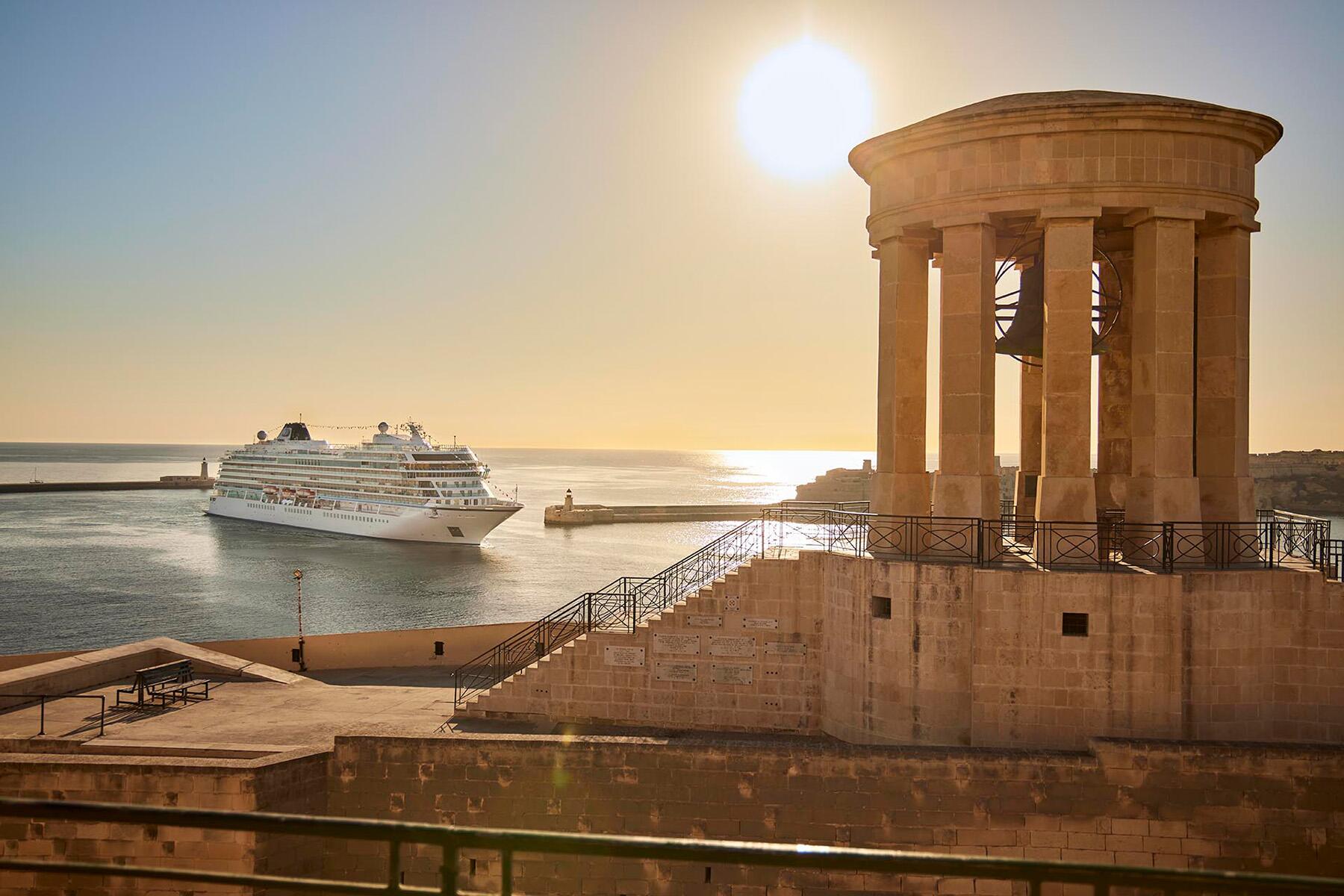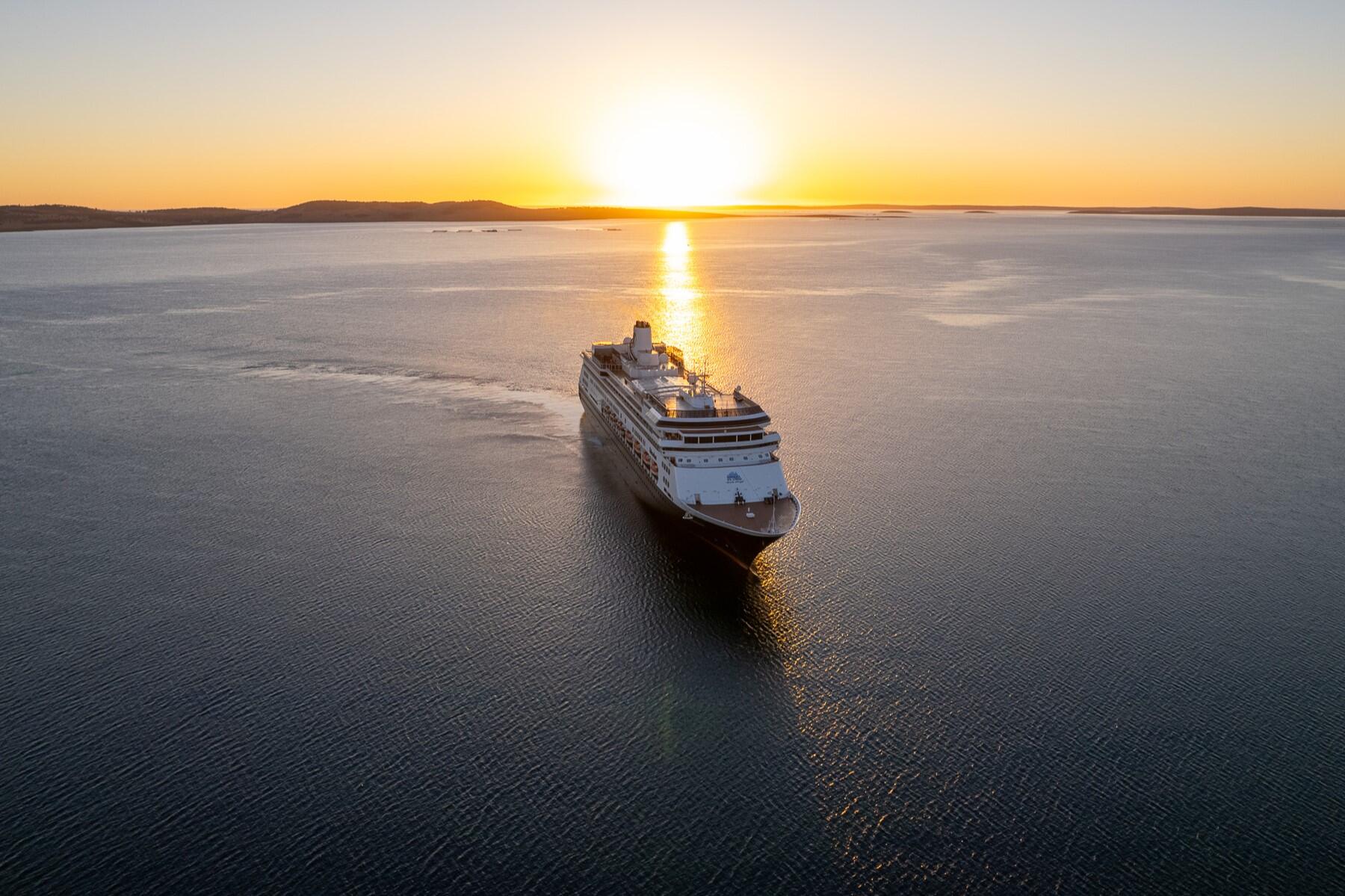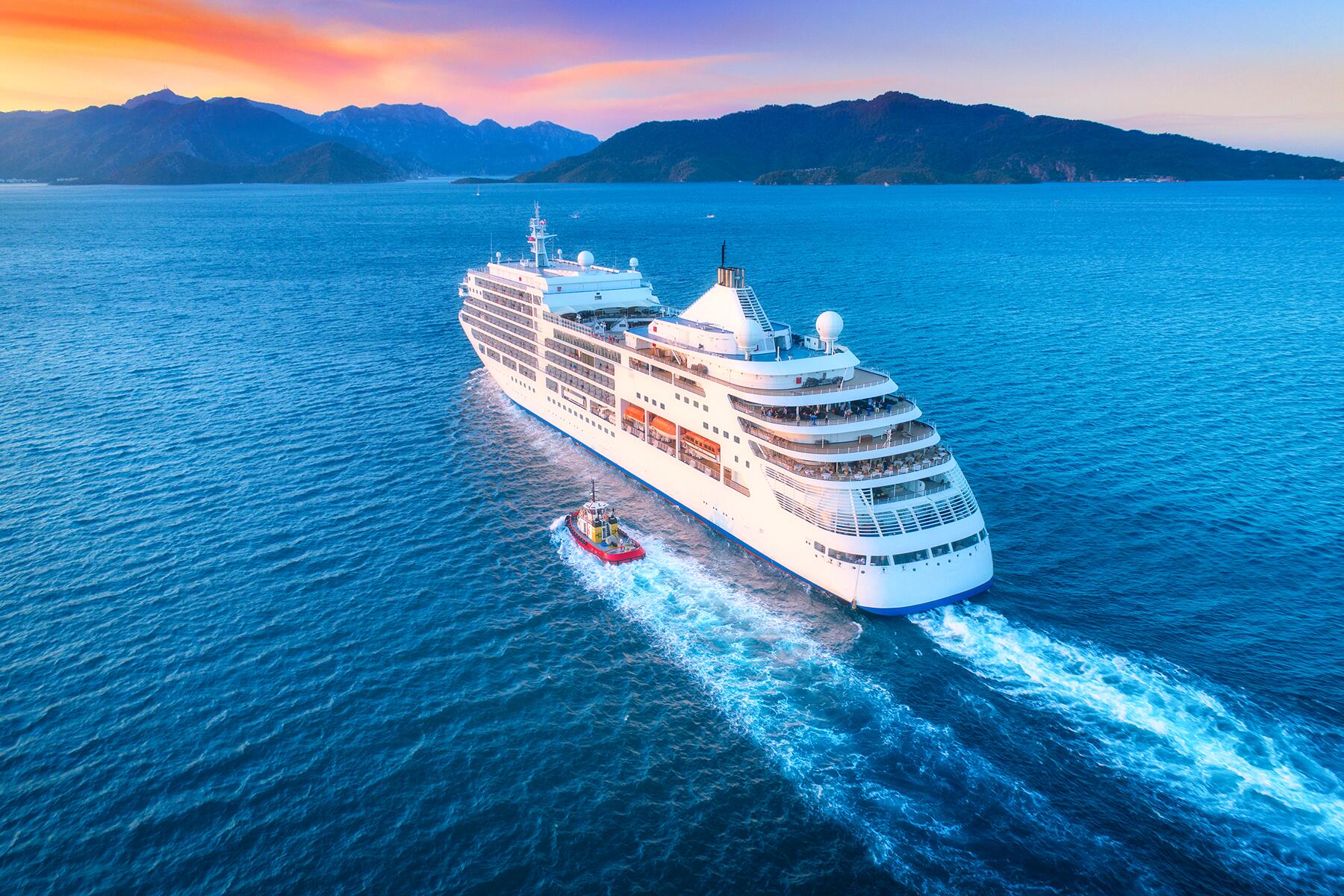Taking a cruise comes with its own language. From "lido decks" to "sea days"—consider this your cruising dictionary.
Cruising is a world unto itself, with a specific vibe, mindset, and an entire vocabulary exclusive to a life lived at sea, whether that’s for just three days in The Bahamas, two weeks across the Atlantic, or a six-month ‘round the world itinerary.
To help you acclimate to this life, here’s a primer on the cruise lingo you are most likely to see, hear, and encounter during your cruise vacation. With our help, you’ll know not only which direction you’re heading onboard your ship, but you will also learn what MDR, OBC, Lido, Muster, and Tender mean.
The Directions of a Ship: Aft, Forward, Port, Starboard
Bow and stern are the official nautical names for the front and back of a ship, respectively. On a cruise, however, you will hear and use the words aft (back) and forward (self-explanatory) to orientate yourself when traversing the length of the vessel. For most people, avid cruisers and landlocked travelers alike, port and starboard are the more difficult terms to remember, but there’s an easy trick that will help. Port is the lefthand side of the ship, and both port and left have four letters. With that sorted, you are left with the right side of the ship or starboard. Now you’ll never get lost during your vacation at sea!
Muster Station and Muster Drill
Every cruise passenger is assigned a muster station based on the location of their stateroom. This is the designated area where you will go in the event of an emergency. You’ll learn where your muster station is and the quickest way to reach it during the mandatory muster drill. All cruise ships are required to hold a muster drill and attendance is compulsory for all passengers. The nature of these drills is evolving from entirely in-person instructions to now watching videos on the ship’s app or cabin television, then checking in quickly at the muster station. No matter how your cruise ship handles it, everyone must complete this process shortly after boarding in order for the ship to leave port and the cruise to officially begin.
Recommended Fodor’s Video
Embarkation and Disembarkation
Embarkation is usually one of the happiest days in a cruiser’s life because this lingo stands for the first day of a cruise, the exciting day you first step on board, see your cabin, eat your first meal, and explore the decks. You’ll get settled in and situated on embarkation day. Conversely, the worst day of the cruise is disembarkation day, the early morning after your bags have been taken away and your last breakfast is enjoyed. It’s here when you begin the process of heading home.
Repositioning Cruise
The vast majority of cruises are what they call closed-loop itineraries, essentially, roundtrips. But, repositioning cruises are a chance to be on board as a ship switches home ports, for example: when a vessel leaves the Caribbean in late spring for its European sailing season (this is also an example of a Transatlantic cruise). Sometimes, good deals can be found in booking these cruises as the ships must move anyway, so cabins are sold at a value to cruisers who are okay with a bulk of sea days in between a few ports of call.

Cruising Ducks
Started by a young woman years ago, the global community of cruisers carrying batches of small rubber ducks on board to scatter around cruise ships is massive. These giddy cruise addicts hide/place ducks all over ships, usually with identifiers carrying the names of the passengers who left them and a hashtag to use when you post a photo of the duck on social media. Silly, yes, but also an adorable and innocent way to be a part of something much bigger than you and to fully integrate into a cruising life.
Port of Call
Any place a cruise ship stops, docks, and allows passengers to disembark for the day is called a port of call. In a port of call, you can often take excursions to have experiences on land, in the sea, or the air, all based on the specific ports your ship is visiting, or spend the day exploring on your own. Most ports of call are daytime-only visits, although some cruises may overnight in port, allowing you to get a flavor of the nightlife in a city.
Sea Day
The days when the cruise ship is moving from one port to another, with no planned stops, are called sea days. These are beloved by avid cruisers because there is a bevy of entertainment scheduled on board, like bingo, art gallery seminars, live music, trivia, and more. Elegant or formal nights often occur on sea days.

Excursion
Sea days are fun and exploring ports on your own can be memorable, but many cruisers opt for excursions offered directly from their ship/cruise line. These provide everything a cruiser will need to have a wide range of experiences and not worry about being left behind should an excursion be delayed by traffic, medical incident, or any other unforeseen circumstance. Excursions bought through the cruise line give you the assurance that you will have transportation to/from, as well as all necessary amenities to have a memorable time, without needing to think about logistics. Some examples of cruise excursions include:
– Seaplane rides over glaciers in Alaska
– Swimming with wild pigs in The Bahamas
– Rum tasting in the Caribbean
– Whale watching
– Walking tours of cities
– Ziplining
– 4×4 tours
– And so much more
Tender
Only one vowel away from a popular dating app, a tender also helps you make an important connection! In cruise lingo, a tender is a small boat that will connect cruise passengers from their ship to land in ports of call where docking is not possible. It’s also a verb! To tender is the action of being on one of these ferry-type vessels taking you to shore, for fun-in-the-sun beach days or your exciting land-based excursions.
Specialty Dining
Every ship has a full roster of complimentary dining options, from pizza and burgers, to its buffet and main dining room(s), but often, a cruise ship will have additional restaurants that charge an extra fee for dinner. These are the specialty restaurants and they can include a steakhouse, Italian trattoria, seafood restaurant, sushi spot, and teppanyaki. The fees vary, but you can expect to pay an additional $20-$60 per person for a dinner at specialty dining destinations on board a cruise ship.
Main Dining Room
Often referred to simply as MDR by frequent cruisers in the know, the Main Dining Room is the prime destination on board a cruise ship for complimentary sit-down meal service at breakfast, dinner, and afternoon tea. Some ships may have more than one (Celebrity Edge class ships, for example, have four distinct MDRs) but every large ship has at least one main dining room, and usually, that venue will have a lobster night, often on the final cruise elegant evening. These nights are extremely popular with cruisers on a budget who want a taste of the finer things usually found only in the specialty restaurants!
Bridge
The bridge on a ship is akin to a plane’s cockpit, only significantly larger. The captain and their first mate, along with other officers, spend their days and nights in the bridge guiding the ship from port to port safely. Some ships offer bridge tours that are educational and entertaining.

Gangway
This is the cruise lingo used for the area of the ship where you get onboard and disembark when your cruise begins, ends, and at ports of call. Many cruise ships have multiple gangways they can use, depending on the tide and height of the pier in port, so you may experience a cruise in which one day your gangway is on deck 3 and at the next port, you are stepping off the ship on deck 5. The location of the gangway will always be clearly communicated via ship-wide messaging over the speaker system and in the app.
All Aboard
A cruise ship is a punctual method of transportation and as such, it will leave ports of call promptly. The all aboard time will be communicated clearly in the ship’s app and the printed daily planner. This time is generally set for 30 minutes before the ship is scheduled to leave port, thus providing a buffer for habitually tardy passengers! Always verify the all aboard time before disembarking in port, especially if you plan to explore that port on your own versus a ship’s excursion. Aside from cases when an excursion is late returning, the ship will leave without you if you are not on board on time.
Cabin Steward and the Crew
Each cabin (or stateroom) has a steward who is responsible for housekeeping (often twice daily), and many other needs a guest may have during their cruise. Your cabin steward will become your best friend during your sailing, delivering fresh towels and extra pillows, making the bed perfectly in the morning and evening, dropping off adorable towel animals nightly, providing you with your cruise excursion tickets, leaving the next day’s daily planner, proving you with your luggage tags the day before disembarkation, and so much more. Many cruisers choose to provide an extra cash tip to their cabin steward for a job well done. “Crew” is the general term for all cruise ship employees, from the steward to servers and beyond.
Cruise Director
The main voice you’ll hear during your cruise isn’t the captain (although she or he will have a few things to say over the speaker system from time to time). Your cruise director is in charge of all the onboard entertainment, often introducing live music on stage, hosting events, and delivering daily updates through the ship’s speakers about what’s happening on board. Some are colorful, others are stoic, but all cruise directors are invested in helping each passenger have fun and make memories during their vacation at sea.
Onboard Credit / Future Cruise Credit
Known simply as OBC to some, onboard credit is any money you may have received as a sweetener or a bonus to book your cruise. Learn about all the different ways you can use onboard credit during your next cruise. Future cruise credit, on the other hand, is lingo that has been very relevant lately, as the cruise industry came to a halt and thousands of future cruises were canceled during the pandemic. Instead of issuing refunds, some passengers receive future cruise credit that works like a gift certificate and can be applied to the base fare of the next cruise they wish to book.

Lido Deck
This deck, usually near the top of the cruise ship, is pronounced LEE-Doe and it is where you will usually find the buffet, pools, hot tubs, deck chairs, outdoor movie screen, and more food and fun. Generally speaking, the Lido deck is the central hub of activity, both inside and out, on a cruise ship.
Friends of Bill W. / Friends of Dorothy
Cruisers may notice daily activities on the app and on the printed-out daily planner that will likely confuse them. “Friends of Bill W.” is code for the Alcoholics Anonymous meetings held onboard, while “Friends of Dorothy” denotes LGBTQA+ meetings and activities. Many ships now list LGBTQA+ activities directly, but some may still prefer the code or slang “Friends of Dorothy” to subtly provide a safe space to mingle, meet, and have fun on board.




